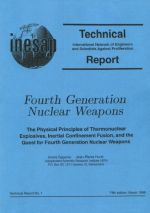
Click for big image




by Andre Gsponer and Jean-Pierre Hurni
Fifth Edition: March 1999
Andre Gsponer and Jean-Pierre Hurni provide an extremely valuable service by issuing this report. The report consists of two principal components
[It should be noted in passing that third generation nuclear weapons include such devices as hot X-ray and enhanced neutron emission ("neutron bomb") thermonuclear weapons, specialized devices that were never procured in large numbers, and have been largely abandoned as of little military interest.]
Of special interest is their excellent and extensive bibliography that brings together many references regarding weapon history, basic weapon physics, and fourth generation weapon concepts. To people interested in these subjects the bibliography aloneis easily worth the modest cost of the publication.
--- Carey Sublette
 Click for big image |
This report is an assessment of the prospect of developing new (i.e., fourth generation) nuclear weapons in the context of the recently agreed Comprehensive Nuclear Test-Ban Treaty (CTBT) and of the current moratorium on nuclear testing in effect in all nuclear-weapon States.
The first chapter is a primer on thermonuclear weapons based on a scientific understanding of the physical principles of existing nuclear weapons and on the results of ISRINEX, a simple thermonuclear explosion simulation program specially developed for independent disarmament experts. Using this insight, it is shown that the construction of hydrogen bombs is in fact much less difficult than is generally assumed. Using present-day nuclear and computer technology, almost any modern industrial country could, in principle, build such a weapon. Similarly, it is shown that "boosting," i.e., the technique of using a small amount of tritium to enhance the performance of a fission bomb, is also much easier than generally assumed. In particular, using this technique, building highly efficient and reliable atomic weapons using reactor-grade plutonium is straightforward. Moreover, independently of the type of fissile material used, the construction of "simple" and "deliverable" tritium-boosted nuclear weapons can be easier than the construction of primitive Hiroshima or Nagasaki type atomic bombs.
The second chapter is a technical and legal analysis of the nuclear tests which are allowed by the CTBT: microexplosions and subcritical experiments. It is found that this treaty explicitly forbids only nuclear explosions in which a divergent fission chain reaction takes place. Therefore, it is possible to develop new types of fission explosives in which subcritical fission-burn is the yield generation mechanism. Similarly, new kinds of fusion explosives, in which the trigger is no longer a fission explosive, are legal under the CTBT. %\smallskip
The third chapter is devoted to the military applications of inertial confinement fusion (ICF) and other pulsed-power technologies. The capabilities of modern laboratory simulation techniques for weapons physics research are shown to significantly overlap with those of underground nuclear testing. Moreover, these technologies are found to enable the study of a number of physical processes --- especially electromagnetic energy cumulation techniques and advanced nuclear processes that are not restricted by existing arms control treaties --- which are useful in refining existing nuclear weapons and essential in developing fourth generation nuclear weapons. %\smallskip
The fourth chapter is devoted to fourth generation nuclear weapons. These new fission or fusion explosives could have yields in the range of 1 to 100 ton equivalents of TNT, i.e., in the gap which today separates conventional weapons from nuclear weapons. These relatively low-yield nuclear explosives would not qualify as weapons of \emph{mass} destruction. Seven physical processes which could be used to make such low-yield nuclear weapons, or to make compact non-fission triggers for large scale thermonuclear explosions, are investigated in detail: subcritical fission-burn, magnetic compression, superheavy elements, antimatter, nuclear isomers, metallic hydrogen and superlasers (i.e., ultrapowerful lasers with intensities higher than 1019 W/cm2).
The conclusion stresses that considerable research is underway in all five nuclear-weapon States (as well as in several other major industrialized States such as Germany and Japan) on ICF and on many physical processes that provide the scientific basis necessary to develop fourth generation nuclear weapons. Substantial progress has been made in the past few years on all these processes, and the construction of large ICF microexplosion facilities in both nuclear-weapon and non-nuclear-weapon States is giving the arms race a fresh boost. The world runs the risk that certain countries will equip themselves directly with fourth generation nuclear weapons, bypassing the acquisition of previous generations of nuclear weapons.
In this context, the invention of the superlaser, which enabled a factor of one million increase in the instantaneous power of tabletop lasers, is possibly the most significant advance in military technology of the past ten years. This increase is of the same magnitude as the factor of one million difference in energy density between chemical and nuclear energy.
A major arms control problem of fourth generation nuclear weapons is that their development is very closely related to pure scientific research. The chief purpose of the CTBT is to freeze the technology of nuclear weapons as a first step toward general and complete nuclear disarmament. In order to achieve that, it is necessary to implement effective measures of preventive arms control, such as international legally binding restrictions in all relevant areas of research and development, whether they are claimed to be for military or civilian purposes.
ISBN: 3-933071-02-X. 183 pages, 25 figures, 4 tables, 528 references (Fifth corrected and expanded version of a report first distributed at the 1997 INESAP Conference, Shanghai, China, September 8--10, 1997.)
Orders should be sent to: IANUS, ianus@hrzpub.tu-darmstadt.de, or by fax to No.\ (+49) 6151-16-6309. Price: $20 + postage.
Copyright, 1997, 1998, 1999. INESAP, c/o IANUS, Darmstadt University of Technology, Germany. All rights reserved. ISBN: 3-933071-02-X.